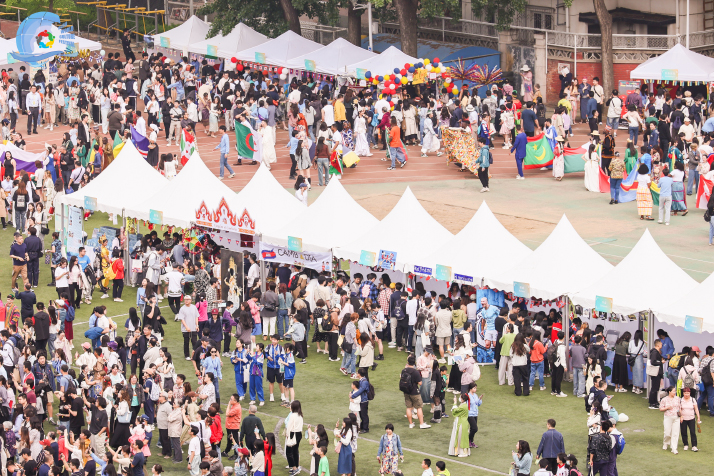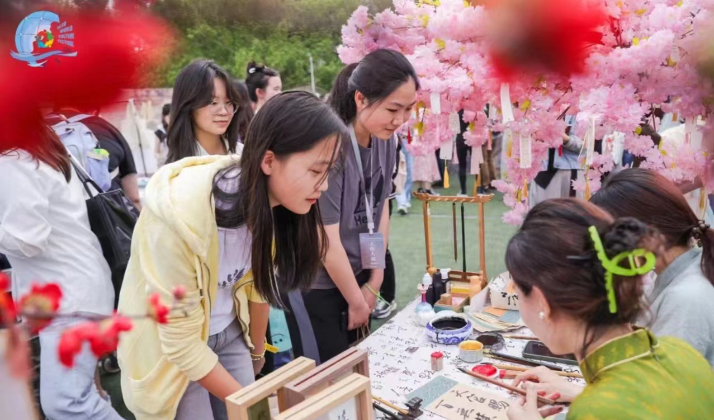| China |
| Prominent language university hosts cultural carnival | |
| One of this festival edition's highlights, according to Duan, was the traditional Chinese culture exhibition zone, featuring a host of globally known cultural elements from China. | |
|
|
 Droves of visitors line up to explore the different booths hosted by BLCU students from different countries on April 27
 Visitors line up to get a personalized note written in calligraphy, a gift from the BLCU event’s traditional Chinese culture exhibition zone, on April 27 COURTESY PHOTO
On April 27, curious visitors flocked to Beijing Language and Culture University (BLCU) in the capital city's Haidian District to catch a glimpse of the school's multinational student parade, with a colorful array of national flags and costumes sweeping through the main street of the campus. This was part of the one-day World Cultural Carnival, a cultural festival that has been hosted annually by BLCU for 20 years running, usually taking place in April or May. This year's edition gathered students from 103 countries. They joined the parade, staged shows and hosted booths where they showcased their cultures through music, costumes, food, illustration boards and handicrafts around the large sports field sitting at the heart of the school's campus. "The festival provides a platform for students of different nationalities to learn from each other," BLCU's President Duan Peng said at the event's opening ceremony. "Since its establishment [in 1962], BLCU has been committed to promoting traditional Chinese culture, boosting mutual learning among civilizations and fostering inter-civilizational communication. This festival is a testament to our accomplishments." The school is renowned for its top-notch Chinese language programs for international students, having cultivated numerous global political and economic leaders. Tapestry of tradition One of this festival edition's highlights, according to Duan, was the traditional Chinese culture exhibition zone, featuring a host of globally known cultural elements from China. "We selected essential elements likely to pique international students' interest and foster their understanding of China," Xuan Zheng, curator of the zone, told Beijing Review. The zone showcased calligraphy, hanfu, or the traditional dress of the Han Chinese, poetry, ink wash painting, old printing techniques, as well as items included on the national intangible cultural heritage lists, such as the skills to produce the Chinese "Money Frog," velvet flowers and colorful silk scarves, taught to visitors by volunteers on site. The zone's entrance featured element from A Panorama of Rivers and Mountains, a classical painting from the Song Dynasty (960-1279) starring mountains, rivers, villagers and different types of vehicles and architectures at that time. "The painting presents the splendid scenery of China, and by 'opening' the zone with it, we wanted to extend an invitation to people from all over the world to enter and become 'a character in the painting' so as to learn more about Chinese culture," Xuan explained. "Our programs are highly interactive. Students can try their hand at creating the frogs and velvet flowers, as well as dip-dyeing their scarves—all guided by our volunteers." Some of the traditional Chinese games offered in the zone, including touhu, in which players must throw arrows or sticks into a large jar from a certain distance, and chuiwan, a game similar to modern golf, also proved to be a hit. Xuan also considered the Chinese language fans, with a poetry quiz section where visitors could win a stamp sporting the BLCU mascot, a koi carp, and traditional Chinese elements by answering questions about Chinese poetry. "Many international students come to BLCU for its Chinese language programs, so I figured this kind of setup would be a good opportunity to help Chinese visitors refresh their memory and to further international students' knowledge about poetry," Xuan explained. Intercultural communication Aliia, a BLCU student from Kyrgyzstan who prefers to be known by her first name, said the festival gave her an opportunity to showcase her nation's culture. As hosts of the Kyrgyzstan booth, she and her friends, dressed to the nines in the country's colorful traditional costumes, became a bonafide sight to behold, and their booth saw visitors lining up to have their picture taken with them. "We are wearing a beldemchi (a richly embroidered wrap-around skirt), the most representative costume for women from Kyrgyzstan," Aliia told Beijing Review. "Our booth has kalpak (wool-felt hats that stand for maturity and wisdom, and are worn for big events and holidays in Kyrgyzstan) for visitors to try on and take photos. We hope they can feel our best wishes and goodwill while wearing the hats." Located on the ancient Silk Road, Kyrgyzstan has a longstanding friendship with China and is one of the earliest countries to join the Belt and Road Initiative, which was proposed by China in 2013 to boost connectivity along and beyond the ancient Silk Road routes. This was Aliia's first time attending BLCU's annual cultural extravaganza, but she already started thinking ahead. For next year's edition, she and her friends are considering bringing traditional Kyrgyz foods, such as beshbarmak, a dish consisting of lamb, noodles, onions and potatoes, and boorsok, a type of fried dough often served during special occasions, to the event, to further showcase the charm of Kyrgyzstan. "I'm fully enjoying this event as a platform for promoting our traditional culture as well as learning about other cultures. Food is one of the easiest cultural forms to connect people from different civilizations," Aliia said. "I believe that visitors will enjoy the dishes and be even more impressed with Kyrgyz culture next year." Wang Huilin, a Chinese student majoring in linguistics at BLCU, found herself amazed by the diverse cultures from other continents. "The hosts of the Bosnia and Herzegovina booth were selling traditional embroidery pieces and handwoven wool socks, as well as post cards featuring their country's spectacular scenery. Every cent earned goes to a charity that preserves endangered species in Southern Europe; I found these souvenirs both meaningful and beautiful," Wang told Beijing Review. Aside from the tangible souvenirs presented by European peers, Wang took home many memories from the Africa booths. "I love the booths of African countries and their hosts are all very enthusiastic," Wang said. "I got my hands painted and also got a traditional African braid at the Zambia booth. With their rhythmic music and group dancing, for a moment there, I felt like I was actually on the African continent." "The hosts of the African booths are so compelling. It seems they just have the magic to attract people to laugh and dance with them," Aliia said. "I've been deeply touched by the scenes here today—people from different backgrounds dancing together, hand in hand; this is the spirit of the global cultural festival." Copyedited by Elsbeth van Paridon Comments to zhangyage@cicgamericas.com |
|
||||||||||||||||||||||||||||
|